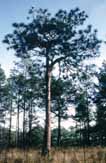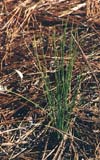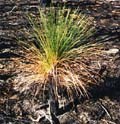
Old-growth specimen, Weymouth Woods State Park, NC [C.J. Earle, Dec-1991].

A seedling in the 'grass' stage, 25 cm tall. Weymouth Woods State Park, NC
[C.J. Earle, Mar-1999].

Young seedling, Weymouth House, NC [C.J. Earle, Aug-1989].

Similar seedling following a low-intensity burn. Carolina Sandhills National
Wildlife Refuge, SC [C.J. Earle, Mar-1999].

Tree scarred for turpentine production. Bark was trimmed annually and sap
collected and distilled to produce turpentine and pine tar. Exposed wood was
charred during ground fires reinstated as a conservation practice, after
turpentine production ceased. Weymouth Woods State Park, NC [C.J. Earle,
Dec-1991].
Common Names
Longleaf pine, longleaf yellow pine, southern yellow pine.Taxonomic notes
Syn: Pinus australis F. Michaux (2).Description
"Trees to 47 m; trunk to 1.2 m diam., straight; crown rounded. Bark orange-brown, with coarse, rectangular, scaly plates. Branches spreading-descending, upcurved at tips; twigs stout (to 2 cm thick), orange-brown, aging darker brown, rough. Buds ovoid, silvery white, 3-4 cm; scales narrow, margins fringed. Leaves (2)-3 per fascicle, spreading-recurved, persisting 2 years, 20-45 cm x ca. 1.5 mm, slightly twisted, lustrous yellow-green, all surfaces with fine stomatal lines, margins finely serrulate, apex abruptly acute to acuminate; sheath 2-2.5(3) cm, base persistent. Pollen cones cylindric, 30-80 mm, purplish. Seed cones maturing in 2 years, quickly shedding seeds and falling, solitary or paired toward branchlet tips, symmetric, lanceoloid before opening, ovoid-cylindric when open, 15-25 cm, dull brown, sessile (rarely short-stalked); apophyses dull, slightly thickened, slightly raised, nearly rhombic, strongly cross-keeled; umbo central, broadly triangular, with short, stiff, reflexed prickle. Seeds truncate-obovoid; body ca. 10 mm, pale brown, mottled darker; wing 30-40 mm. 2 n =24" (2).Range
USA: Virginia, North Carolina, South Carolina, Georgia, Florida, Alabama, Mississippi, Louisiana and E Texas at 0-700 m elevation on the Atlantic and Gulf coastal plains. Typical habitat dry sandy uplands, sandhills, and flatwoods (2). See also (3). Although it formerly occupied a large fraction of this range, logging and conversion to other, more easily-managed species (native pines such as P. elliottii and P. taeda ) have greatly reduced its range.Big Tree
Diameter 93 cm, height 34 m, crown spread 15 m, located in Covington County, MS; also, diameter 74 cm, height 41 m, crown spread 12 m, located in Wilkinson County, MS ( American Forests 1996 ).Oldest
In 1990, a ranger at the Weymouth Woods Nature Preserve in NC (see below) told me that one tree in the preserve had yielded a core with a ring count of 462 years.Dendrochronology
Ethnobotany
It is a valued species for lumber and pulpwood and was once important for naval stores (e.g., turpentine, pine oil, tar, pitch) (2).Observations
Have seen in the Sand Hills district of North Carolina, an area that once supported a flourishing turpentine industry based on the pines. The Weymouth Woods Nature Preserve in the town of Southern Pines provides an excellent place to see an old-growth longleaf stand, managed for frequent fire and inhabited by red-cockaded woodpeckers.Remarks
Pinus palustris is adapted to frequent low intensity fire. Relevant adaptations include:- a deep taproot and a definite grass stage, which permit seedlings to lose foliage and yet survive low intensity fires (an adaptation also found in various other pines, notably P. engelmannii in Arizona);
- profuse production and shedding of needles and ready shedding of lower limbs, which provide a rapid accumulation of fine fuels, sufficient to support ground fires at frequencies as often as 3 years;
- an extremely flammable heartwood and sapwood shielded by a relatively fire-resistant bark. Consequently, snags and large dead wood accumulations are rare.
Old-growth longleaf pine stands are the preferred habitat of the endangered red-cockaded woodpecker, Picoides borealis , which nests in cavities that it excavates in the trunks of living pines. The rarity of old-growth stands has led to designation of the woodpecker as endangered, and has thus been the primary driver behind efforts to preserve the remaining old stands and (a much more difficult problem in view of traditional Western cultural biases against wildfire) to restore such stands to a frequent fire regime. In the absence of fire, longleaf stands are doomed by the invasion of understory hardwoods such as turkey oak ( Quercus laevis ) and blackjack oak ( Q. incana ). These species produce dense understory shade, preventing the establishment of pine seedlings, and they also compete directly with adult pines for water and nutrients.
Longleaf pine is the state tree of North Carolina (2).
Citations
(2) Kral in Flora of North America online .(3) Robert S. Thompson, Katherine H. Anderson and Patrick J. Bartlein. 1999. Atlas of Relations Between Climatic Parameters and Distributions of Important Trees and Shrubs in North America. U.S. Geological Survey Professional Paper 1650 A&B. URL= http://greenwood.cr.usgs.gov/pub/ppapers/p1650-a/pages/conifers.html , accessed 22-Jan-2000.
See also:
Burns, R.M. and B.H. Honkala. 1990. Silvics of North America, Vol. 1, Conifers. Washington DC: U.S.D.A. Forest Service Agriculture Handbook 654. http://willow.ncfes.umn.edu/silvics_manual/Table_of_contents.htm .
The FEIS database .
Anantha M. Prasad and Louis R. Iverson. 1999. A Climate Change Atlas for 80 Forest Tree Species of the Eastern United States. http://www.fs.fed.us/ne/delaware/atlas/ . Delaware, Ohio: USFS Northeastern Research Station.
back | Pinus | Pinaceae | home
This page is from the Gymnosperm Database
URL: http://www.geocities.com/~earlecj/pi/pin/palustris.htm
Edited by Christopher J. Earle
E-mail:
earlecj@earthlink.com
Last modified on 28-Jan-2000